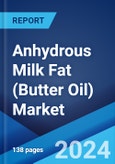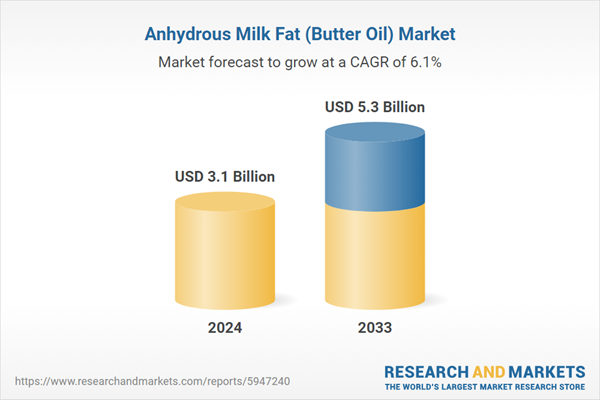Increasing Consumption of Fast-Food Stimulating Market Growth
At present, the thriving fast-food industry is propelling the demand for anhydrous milk fat (butter oil). In addition, the increasing utilization of anhydrous milk fat in manufacturing recombined dairy products, such as condensed milk, is contributing to the growth of the market. Moreover, the rising number of fast-food joints around the world selling flavorful dishes at affordable prices is supporting the growth of the anhydrous milk fat (butter oil) market. Besides this, fast food joints are adopting effective marketing strategies and collaborating with food bloggers and vloggers to connect with their targeted audience and increase their sales. They are also providing extra discounts, home delivery, and takeaway services to cater to a greater number of customers, which is catalyzing the demand for anhydrous milk fat (butter oil). Additionally, the rising trend of working from cafes, conducting business meetings, or arranging get-togethers in restaurants or cafes is supporting the growth of the anhydrous milk fat (butter oil) market. Apart from this, the increasing popularity of various fried foods, such as French fries, falafel, egg rolls, spring rolls, tempura, fritters, and chicken nuggets and wings, is strengthening the growth of the market. Furthermore, the growing consumption of various fried foods and ready-to-eat (RTE) food products among working individuals to save time and suppress appetite is creating a substantial demand for the global anhydrous milk fat (butter oil) industry.Competitive analysis such as market structure, market share by key players, player positioning, top winning strategies, competitive dashboard, and company evaluation quadrant has been covered in the report. Also, detailed profiles of all major companies have been provided. The structure of the anhydrous milk fat (butter oil) market is fragmented, with a large number of global and regional key players operating and engaging in various mergers and acquisitions (M&A). The product differentiation rate is low, and the volume of new entrants in the market is also low due to the requirement of high capital investment and sophisticated machinery, difficult procurement process of raw materials, and stringent government regulations.
What is Anhydrous Milk Fat (Butter Oil)?
Anhydrous milk fat (AMF) refers to a compound extracted by separating oil fat from the cream or milk through the process of centrifugation. It involves removing the water content from milk to procure the fat concentrate, which contains pure milk fat. It is yellow in color and possesses a buttery and cream-like texture. It is manufactured by chilling raw milk, standardizing it by adding fat, protein, and other nutrients, pasteurizing, aging, churning, vacuum treating, and finally refining to achieve accurate flavor and texture. It stays liquid at temperatures above 36 degrees and solidifies at temperatures below 16-17 degrees and does not contain any additives, preservatives, or fatty acids. It has a longer shelf life, which facilitates easy transportation and storage. It does not require refrigeration during transportation and the quality depends primarily on free fatty acid levels, contamination by other oils and fats, and measurement of oxidative deterioration, such as peroxide value and anisidine value. It offers numerous nutritional benefits and contains high quantities of vitamins A, D, E, and K2 and calcium which are essential for maintaining proper bone health, preventing the occurrence of arthritis, and boosting immunity. It is incorporated in a wide range of recombined dairy products, such as whole milk, cheese, spreads, and ice creams. It is added to soups and sauces for providing a smooth and creamy texture and is utilized in frying, deep frying, roasting, grilling, and sauce-making purposes. It is also employed in the production of shortbread, butter cookies, pound cakes, and pastries and incorporated into praline fillings, chocolate, and chocolate bars, as it forms less fat bloom on the surface of chocolates.
Anhydrous Milk Fat Market (Butter Oil) Trends
At present, the increasing demand for AMF due to the shifting trend of consuming dairy-based diets represents one of the primary factors influencing the market positively. Besides this, the rising demand for AMF in the food and beverage (F&B) industry to produce various processed food products is propelling the growth of the market. In addition, the growing demand for organic AMF produced from the processing of organic milk due to increasing health consciousness among the masses is offering a favorable market outlook. In line with this, the wide availability of input suppliers providing fodder, animal feed products, and veterinary products to maintain the proper health of cattle is impelling the growth of the market. Apart from this, the rising utilization of AMF as an alternative to butter, as it possesses a longer shelf life and does not require costly storage requirements, is contributing to the growth of the market. Additionally, the increasing popularity of various fusion food products among the masses is bolstering the growth of the market. Moreover, governing agencies of various countries are investing in the dairy sector to increase the production of milk and other dairy products. They are also encouraging manufacturers to strengthen the distribution network to increase their geographical presence, diversify the market, and maintain inventory. Furthermore, key market players are adopting advanced machinery to speed up the process of AMF production. They are also focusing on collaborating with raw material suppliers to get milk at fixed prices and minimize the issue of fluctuating supply costs and hire skilled and unskilled manpower to manage various labor-intensive processes in AMF production.Market Segmentation
This report provides an analysis of the key trends in each sub-segment of the global anhydrous milk fat (butter oil) market report, along with forecasts at the global and regional level from 2025-2033. The report has categorized the market based on end-use.End Use Insights
- Dairy
- Bakery
- Confectionary
- Others
Regional Insights
- Oceania
- Europe
- North America
- Asia
- Latin America
- Middle East and Africa
Competitive Landscape
The report has also provided a comprehensive analysis of the competitive landscape in the global anhydrous milk fat market. Some of the companies covered in the report include:- Fonterra
- Dairy Farmers of America
- Hilmar Cheese Company
- Murray Goulburn
- Westland Milk Products
- Synlait Milk Limited
Key Questions Answered in This Report
1. What was the size of the global anhydrous milk fat (butter oil) market in 2024?2. What is the expected growth rate of the global anhydrous milk fat (butter oil) market during 2025-2033?
3. What are the key factors driving the global anhydrous milk fat (butter oil) market?
4. What has been the impact of COVID-19 on the global anhydrous milk fat (butter oil) market?
5. What is the breakup of the global anhydrous milk fat (butter oil) market based on the end-use?
6. What are the key regions in the global anhydrous milk fat (butter oil) market?
7. Who are the key companies/players in the global anhydrous milk fat (butter oil) market?
Table of Contents
Companies Mentioned
- Fonterra
- Dairy Farmers of America
- Hilmar Cheese Company
- Murray Goulburn
- Westland Milk Products
- Synlait Milk Limited
Table Information
| Report Attribute | Details |
|---|---|
| No. of Pages | 141 |
| Published | February 2025 |
| Forecast Period | 2024 - 2033 |
| Estimated Market Value ( USD | $ 3.1 Billion |
| Forecasted Market Value ( USD | $ 5.3 Billion |
| Compound Annual Growth Rate | 6.1% |
| Regions Covered | Global |
| No. of Companies Mentioned | 6 |









